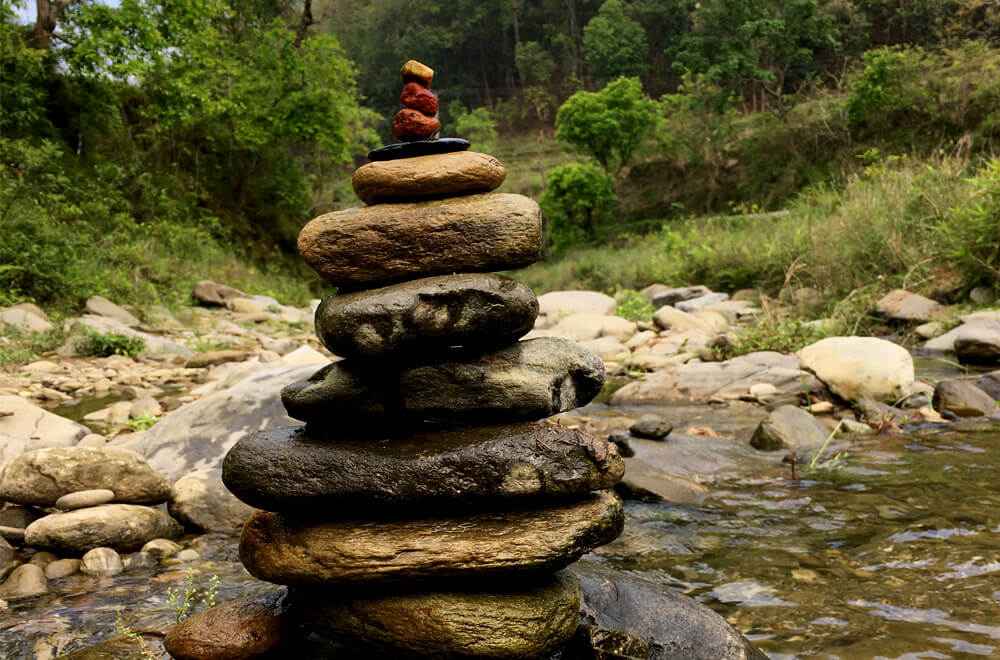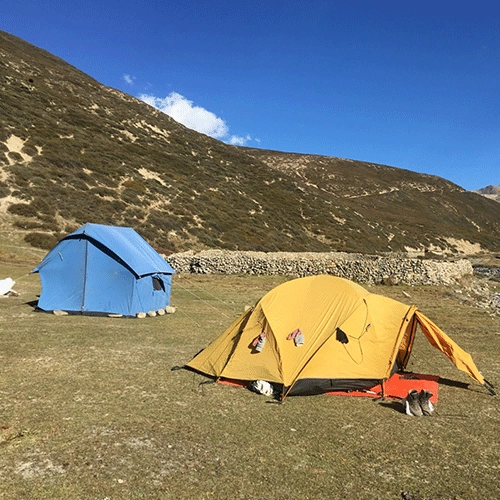The Symbol of the fluttering five-colored prayer flags (called "Lung-Ta" in Tibetan, or "Wind Horse") and the Cairns (stack of stones placed carefully in alignment beside rivers and at mountains is almost identical to hallmarks of trekking in Nepalese Himalayas.
Prayer Flags and Cairns in the Himalayas - What Do They Symbolize?
Table of Contents
History of Prayer Flags in Buddhism and Bön Sects in Nepal
The prayer flag tradition has a long continuous history dating back to ancient Persia. The meanings behind the traditional texts and symbols in the flag are based on the most profound concepts of Buddhist philosophy.
In Nepal, the prayer flags date back thousands of years to the Bön tradition that pre-dates Buddhism.
Shamanistic Bönpo priests used primary-colored plain cloth flags in healing ceremonies. Even today, many regions in Nepal, like Dolpo Trek and the Tsum Valley, for example, have sects that follow this ancient tradition.
The shamans used the flags to harmonize the elements of the body in ceremonies, helping to produce a state of physical and mental health.
The Meaning of Buddhist Prayer Flags
When embarking on a Trek to Everest Base Camp or Annapurna Circuit, one is sure to encounter the mesmerizing sight of prayer flags adorning the landscapes. These colorful flags are printed with powerful mantras and prayers, seeking blessings for prosperity, good health, world peace, and harmony. Their presence adds a profound spiritual touch to the journey, as they are hung with the ultimate intention of liberating from all suffering.
Flags often are decorated with five colors that represent the five elements, with tinctures ranging from gross to subtle colors (yellow as earth, green as water, red as fire, white as air, and blue as space).
The ancient Buddhist prayers, mantras, and powerful symbols displayed on the flags are believed to produce a spiritual vibration that is activated and carried by the wind across the country.
These silent prayers are like blessings spoken on the breath of nature. Just as a drop of water can permeate the ocean, prayers dissolved in the wind extend to fill all of the space.
Prayer Flags for Nature
Colored flags were also used to help appease the spirits of the mountains, valleys, lakes, and streams. The people believe that elemental beings when provoked, cause natural disasters and disease.
Thus, balancing the outer elements and propitiating the elemental spirits with rituals and offerings is the Bönpo way of pacifying nature.
Assimilation of the symbols on Prayer Flags
Whether or not the Bönpos ever wrote words on their flags is not entirely known; the pre-Buddhist religion of Bön was of oral traditions with writing limited to government bookkeeping. On the other hand, the very word, “bönpo,” means “one who recites magical formulas”.
Thus, even if no writing was added to the plain strips of cloth, it is likely that the Bön priests painted sacred symbols on them. Many symbols seen on Buddhist prayer flags today have Bön origins, their meaning enhanced by the deep significance of the Vajrayana Buddhist philosophy.
Prayer Flag Symbols

By definition, symbols have meanings larger than their mere appearance. In the case of sacred Buddhist symbols, the meanings often hint at vast notions beyond words. Listed below are brief meanings of some of the more common symbols found on prayer flags-
The Wind Horse (Lung-Ta)
Carrying the “Wish Fulfilling Jewel of Enlightenment”, the symbol of the White Horse is the most prevalent symbol used on prayer flags. It represents good fortune. When the Wind Horse's blessing is amiss, it is believed that obstacles constantly arise.
Good opportunities abound when the Wind Horse blesses the land. Raising the Wind Horse prayer flag is a way to raise the elemental blessing of good fortune.
The Eight Auspicious Symbols (Tashi Targye)
The Tashi Targye is one of the most popular symbol groupings. It is also one of the oldest, mentioned in the Pali and Sanskrit canonical texts of Indian Buddhism. These Eight Symbols of Good Fortune are-
- The Parasol- which protects from all evil
- The Golden Fish- represents happiness and beings saved from the sea of suffering
- The Treasure Vase- a sign of fulfillment of spiritual and material wishes
- The Lotus- symbol of purity and spiritual unfolding
- The Conch Shell- proclaims the teachings of the enlightened ones
- The Endless Knot- symbolizing the meditative mind and infinite knowledge of the Buddha
- The Victory Banner- symbolizes the victory of wisdom over ignorance
- The Dharma Wheel- a symbol of spiritual and universal law
The Vajra
The symbol of indestructibility, the Vajra in Buddhism represents true reality, the being or essence of everything existing. This pure emptiness is unborn, imperishable, and unceasing.
The Four Dignities
The Four Dignities are represented by four animals: the Garuda, the Sky Dragon, the Snow Lion, and the Tiger. They are seen in the corners of many prayer flags, often accompanying the Wind Horse.
Representing the qualities and attitudes necessary to be developed on the spiritual path to enlightenment, the four dignities symbolize qualities such as awareness, vast vision, confidence, joy, humility, and power.
The Union of Opposites (Mithun Gyulgyal)
An interesting group of symbols, the Union of Opposites are mythological beings that are joined by rival pairs of animals, created to symbolize harmony. A snow lion and a garuda, normally mortal enemies, were combined to form an animal with a snow lion’s body and a garuda’s head and wings.
Likewise, a fish was put together with an otter, and a crocodile-like chu-skin was paired with a conch shell. These composed creatures are often put on Victory Banners, representing the reconciliation of disharmony and disagreement.
The colors of the Prayer Flags and the Elements
Vajrayana Buddhism divides the phenomenal cosmic world into five basic energies. They manifest as earth, water, fire, air, and space. On a spiritual level, the basic energies correspond to the 5 Buddha Families and the 5 Pearls of Wisdom.
The Prayer flags reflect this comprehensive system through color. As stated, each of the 5 colors relates to an element and an aspect of the enlightened mind.
With the synchrony of colors following yellow, green, red, white, and blue, the tinctures correspond to elements; Blue for space, White for air (sometimes referred to as wind or cloud), Red for fire, Green for water, and yellow for the earth.
Cairns in the Nepali Himalayas
The careful stacking of stones, called cairns, are often path-markers on a high pass trekking trail. While this is true for Nepal as well, cairns hold a much more cultural meaning than just direction-pointers. Both Hinduism and Buddhism, two major religions of Nepal, have philosophies that indicate every sentient being is connected to the universe.
As such, many cultural symbolisms occur in the form of stones in both Hindu and Buddhist legends. For example, Hindu people believe that ammonites, or Shaligrams, are incarnations of Lord Vishnu.
Likewise, cairns are built, often at Himalayan ridges or near water bodies, to represent the natural element and the deities. Cairns in the Himalayas are also often ornamented with prayer flags. The stones are often arranged in a certain way, with some even worshipped as alters to the gods.






